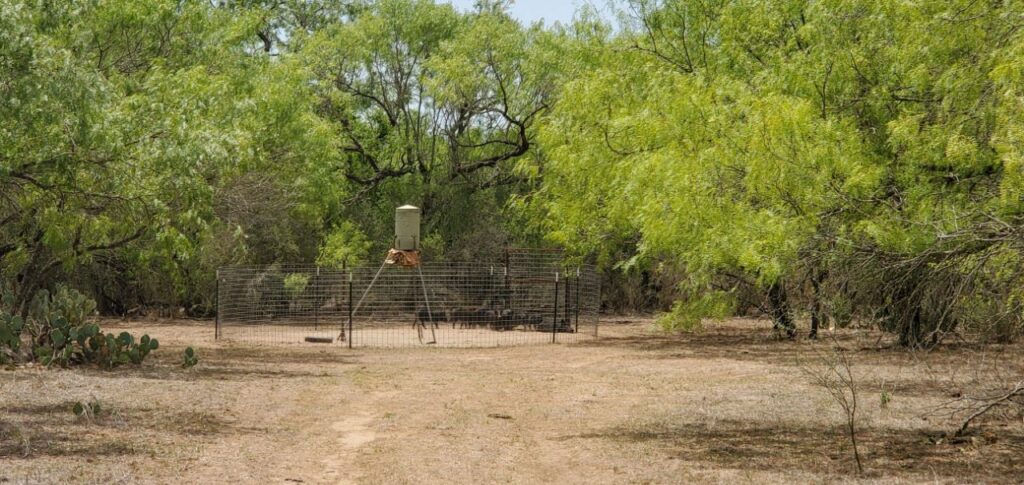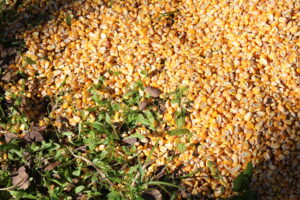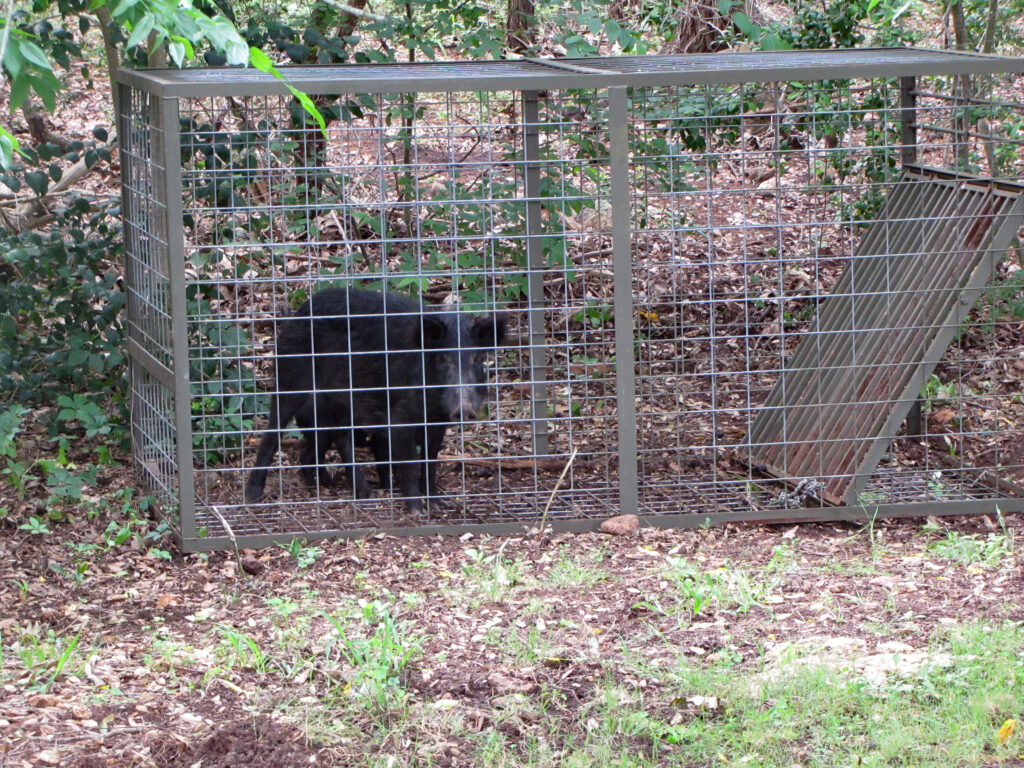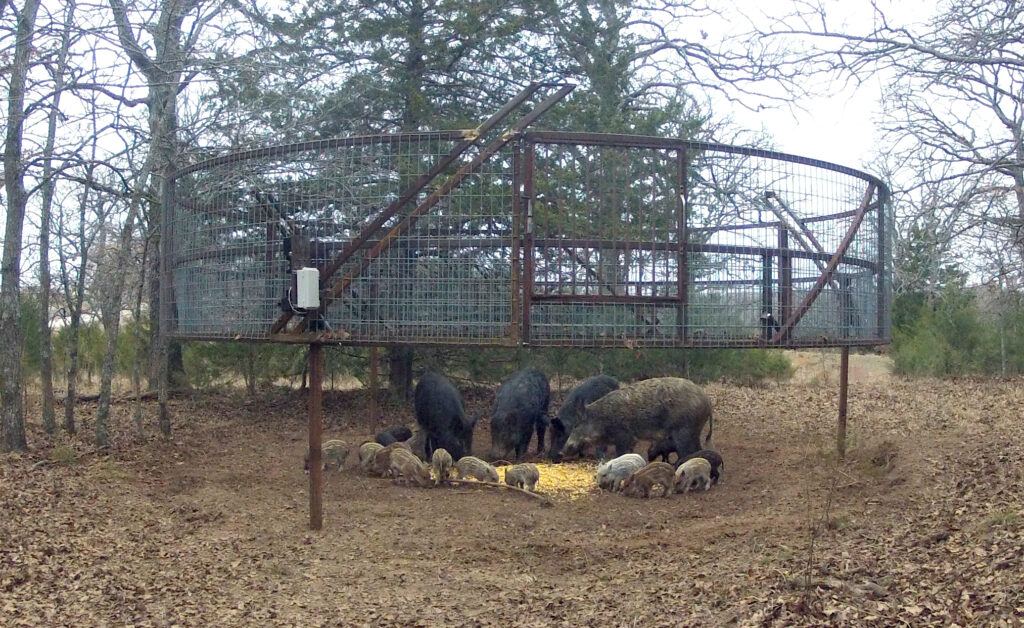There are a variety of traps designed specifically for catching feral hogs that you can build yourself or purchase already constructed. The best trap for each operation will vary based on resources, goals, and quantity of pigs to be removed. Regardless of what kind type of trap you select, placement and baiting practices will greatly impact your chances of success.
When you make it to the point where you are actively trapping, it is important to check the trap daily. This can be accomplished by physically going to the trap or with cameras that provide monitoring information to your phone. Typically, it is best to check first thing in the morning, but they absolutely need to be checked within 24 hours and before the day heats up. Even though trapping is part of lethal removal, it is important that the process is humane and that any accidental captures of native wildlife do not violate game laws.
Trap Placement
One of the first considerations in trapping is the placement of the trap. To be successful, managers should identify an area frequently used by feral hogs. Signs of feral hog activity include scat, tracks, rooting damage, and wallows. Proximity to water and game trails can also be helpful for successful trap placement. Before construction or placement of a trap, bait and game cameras can be used to confirm the trap location is regularly visited by pigs.
Trap Baiting
There are a variety of bait types that are attractive to feral hogs. Commonly used baits include deer corn, soured corn, manufactured baits, or ripening crops found on the landscape such as peaches or peanuts. To truly be successful, bait must be regularly available before, during, and after trapping.
Pre baiting, or baiting before the trap is placed or set, will ensure that pigs are comfortable enough to actually enter the trap once it is assembled. When pre baiting, managers should ensure that bait is available every single day to help make that location part of the hog’s regular travel pattern. We recommend limiting the amount of bait available so that the hogs finish the bait each time they visit the suggested trap site. Limiting bait quantities is more cost effective, but will also encourage hogs to return daily to use the resource before it runs out.
Baiting once the trap is on site follows very similar protocols. Bait should be available daily and in quantities that can be finished by the group of pigs you are targeting. Bait placement will vary slightly depending on the type of trap selected, but general practices recommend that all available bait be inside the trap, bait lead to the rear of the trap to encourage entry, and larger quantities of bait be placed near the trigger.
Once you have successfully trapped, dispatched, and removed pigs from the trap, a short period of post-baiting is recommended. Continued baiting will allow you to determine if all of the pigs from the original sounder were successfully captured, or if any additional sounders are in the area able to be trapped. Common pig traps can be split into 4 categories: corral traps, box traps, drop traps, and net traps.
Corral Traps
Corral traps are a very successful trap style for catching feral hogs because their large size can facilitate capturing entire sounders at once. These traps can be purchased prefabricated or constructed at home with supplies easily found at a hardware store. The primary components of a corral trap are cattle panels, t-posts, a headgate, and a trigger mechanism. For greatest success, we recommend spacing t posts in a circular pattern every 4 feet and ensuring that there are no corners anywhere in the trap. Corners can provide a point for pigs to concentrate on that can sometimes lead to escape.
Typical headgates for these traps include funnels, rooter gates, guillotine, and saloon doors. Managers should select the headgate that works best in their specific situation. Funnels and rooter gates have the potential to be continuous meaning that new pigs can still access the trap and be caught even after the gate closes on the first pigs to enter. This can only be achieved with adequate pre-baiting that teaches the pigs to use and be comfortable with the gate. Saloon and guillotine gates only close after a trigger is set off.
There are an abundance of trigger mechanisms available, but the majority can be split into nonspecific triggers and pig specific triggers. Nonspecific triggers mean that any animal could potentially set them off. They most often include pressure plates, trough triggers, and trip wires. To improve the efficiency of non-specific options, it is recommended that they are set near the back of the trap and adjusted so that only large animals with be able to activate the trigger. Pig specific triggers rely on behaviors commonly observed in pigs to be triggered. These devices include a rooter stick or tire trigger, both of which rely on rooting behaviors, or a bucket trigger that can only be activated by a large animal thereby excluding many non-targets.
An alternate option to a physical trigger is a remote activated trigger based on a camera. This option is typically more costly and does require cell service, but can allow managers to see exactly how many pigs are present before closing the gate which can be helpful in catching complete sounders or groups.

Box Trap
Box traps are a popular option due to their mobility. Once assembled, these traps can be moved from one location to the next loaded in the back of a pickup truck or on a small trailer depending on the size. Because these traps are smaller than other designs, they are able to catch fewer pigs. With appropriate pre-baiting they can catch a small sounder of two sous and several juveniles, or a loan boar hog. If scouting has shown that you have small groups of pigs, or if you are working in an area with limited space, box traps may be a good fit.
Box traps come with a variety of modifications and customizations. Some traps have an open bottom placed directly on the ground. This style trap should be secured into the ground so that large animals cannot tip the trap over and escape. Some box traps have paneling on all sides, the top, and the bottom which can be highly effective for preventing escape. Unfortunately, this can also prevent non targets such as deer and raccoons from escaping. The trap can be modified to have an open top with a shelf to allow raccoons to exit the trap, but the device should be carefully and frequently monitored to ensure that no deer are captured.
For more information on box traps, check out our box trap publication.
Drop Traps
Drop traps typically consist of a large circular fence suspended in the air that can be quickly dropped to surround a group of pigs. These traps are often purchased prefabricated, but plans to build this kind of trap yourself can be found online. Depending on the design, the trap may need to be anchored into the ground or may be heavy enough to stand alone.
An important note for this style trap is that bait should be placed in the center of the trap NOT the perimeter. When the trap drops, it does so at a very high speed. Appropriate bait placement can help to ensure that all animals are in the center of the trap, not at the edge blocking the path of the trap.
Net Traps
Net traps are a newer trap variety. These traps are circular, but instead of a perimeter fence, they have a perimeter net. They are large enough to catch a typical sounder, and allow for continuous access to new pigs even while earlier pigs are already trapped.
These traps have been shown to be a very useful tool in areas where vehicular access would make bringing in larger trap equipment more difficult. The trap does involve multiple anchor points, so to suitably soft ground for t-posts must be available or dense tree coverage that can be used to tie off the trap.



